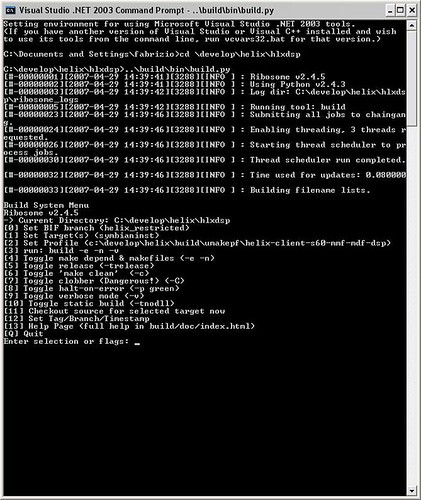Bofore you start reading those lines I would let you know that my intention is not to provide a user guide. I would like to express my disappontment on Helix community's tools and if you reached this post googling in search of a solution probably you will agree with me and join the rant.
What is Helix? Briefly it is a suite of products offering multimedia features for several OS (Windows, Linux, Mac, Symbian). I said 'suite' because under the Helix label you can find a producer (to create multimedia contents), a player (to play them), a DNA client (the engine which runs below the player) and something more.... Sorry for the quick and dirt definitions but don't want to go out-of-scope. In case you discover Helix for the first time go to their site.
Those products are managed by the Community and are - for the most part - open source so anyone could join the Community to access source files and eventually give her contribution.
My experience with Helix started a year ago and it is limited to Symbian version so the following conclusions could not be applied to the whole Community.
The first source of information is of course the web site, which recently had a restilying that greatly improved navigation. But no way to download source files...they are managed through a repository to be accessed via ssh and cvs. The instructions are described but too often on the Helix mailing lists and forum the recurring question: "How to download sources?" is present. Once the connectivity problem is solved the next one is to get the files and choose the right ones? A bunch of Python scripts do the job but once again having the good setup is not straighforward....too many dependencies and environment variables to setup! How can I imagine that my web cam software could impact Helix scripts?
Ok..now that you have the right configuration to run the build script..run it and here the result:

To download the right files you have to configure the branch, the target and the profile you wish. Uhm....what are these? The first help is always the web, so come back to Helix site and surprisingly very poor descriptions (when available) on different profiles, target, branches. So you start guessing what will be the right one....really painfull experience.
What are the roots of these complexity?
Probably the intention to have a cross platform, multiple version source file management system. Really appreciable! But more complex the system is more need of information you need. Otherwise it is useless to build a community and to open sources if you do not improve partecipation.
Mailing list and forum are great means to share knowledge but I think that newbie questions facing above problems are too frequent, so the problem is elsewhere. It is in the official documentation: poor, hard to find, out-of-date.
Indeed adding fresh documents takes time and priorities often are on products delivery so I guess that Real Networks' (the owner of Helix ) engineers have little time to answer to newbies question and update documentation....so why do not exploit better the power of independent contributors?
Hey, have anybody in Real Networks never heard about Wiki? I'm not an expert on Wiki but have a look at what Nokia did with Forum Nokia Wiki. This is a quite recent iniziative but contents are growing so fast! And Nokia already had a really crowded forum to assist developers....but even this forum suffers of lack of official contributors and recurring questions.
I recently proposed Wiki adoption for my working team and even if advantages are not immediate, using it is the best way to discover it.
Blogged with Flock
Labels: Helix, Nokia, Real Networks, wiki





